Lettuce (Lactuca sativa), a member of the sunflower family Asteraceae, follows only potatoes as the most widely grown fresh vegetable in the United States today. Originally cultivated from its wild parent thousands of years ago in ancient Egypt, lettuce consumption had spread by the late 1900s to be enjoyed the world over (Harlan 1986). Americans eat 30 pounds annually per capita—five times more than a century ago. Lettuce is an excellent source of vitamins A and K as well as a good amount of C, some B vitamins, and other phytonutrients. Darker green and red leaves of certain lettuce varieties provide more overall nutrition than lighter green ones (Bunning and Kendall 2012).
Ranking behind only California and Arizona as the US's third-largest producer of lettuce in the country, Florida enjoys nearly year-round growing potential. Though typical commercial lettuce production extends from late September through May, with correct variety selection and protected culture strategies, lettuce is a crop that can present even the novice grower with a fast-growing commodity for market sale. Given more marketing opportunities for specialty crops than ever before, such as farm-to-school programs, restaurants/chefs, farmers markets, and CSAs (Community Supported Agriculture programs), farmers can rely on lettuce as a steady and profitable commodity for any size operation (Hochmuth and Cantliffe 2012).
Why Hydroponics?
The "local food movement" in the U.S. continues to grow as consumers of produce are interested in knowing specifically where their foods originate, how far they have traveled from farm to market, and what health benefits can be provided by these fresh offerings. This trend has brought about significant gains in Florida, particularly in the numbers of small- and medium-scale farm operations which aim to target this hungry marketplace of consumers. However, with urbanization (particularly in south Florida) of once-plentiful agricultural lands, issues over water availability, loss of key chemical inputs necessary to overcome soil-borne pathogens and insect pressures, and market preferences, the hydroponics industry presents itself as a viable alternative growing method to address many of these issues. In the past 40-plus years, Florida has seen a recent very rapid increase of protected culture agriculture from 20–30 acres in the 1970s, to 95 acres in 2001, to over 385 acres in 2013 (Hochmuth and Toro 2014). Hydroponic farms of all sizes operate year-round within greenhouses, high tunnels, shade houses, open field systems, and many variations in between.
Hydroponic Lettuce Systems in Brief
Regardless of the methods of protecting crops in Florida, several hydroponic systems serve as the industry preference for lettuce cultivation. The predominant design in greenhouse lettuce production remains the Nutrient Film Technique (NFT). Consisting of plastic or other lightweight channels, gutters, or tubes, there are compartments in each container holding multiple transplants, while a thin film of nutrient solution trickles over the bare roots of each plant. The nutrient solution is initially stored in a reservoir, pumped out into these channels at a sloped angle, drained down to a catchment system, then filtered or aerated and cycled back to the reservoir for reuse (Figure 1).
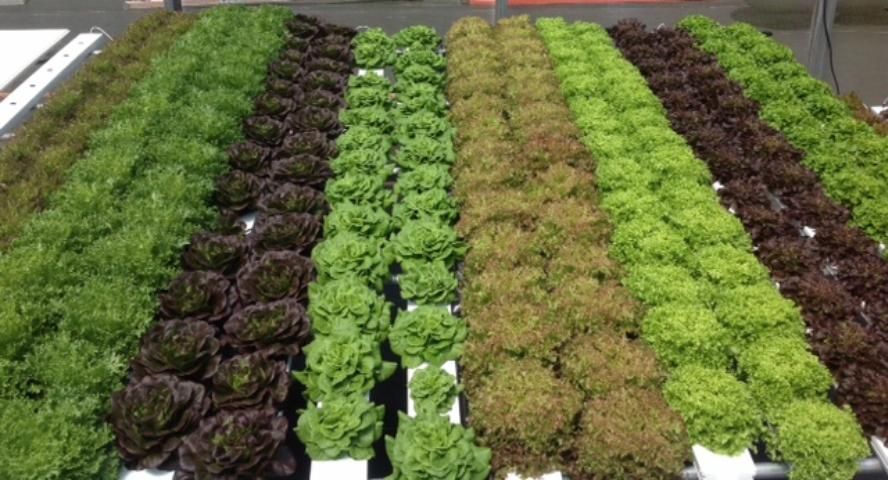
Credit: UF/IFAS
Another common but less complicated technique is the floating raft method of lettuce production. The simplest of all production systems, it consists of a thick sheet of extruded polystyrene foam (i.e., Styrofoam™), which floats on top of a container of a nutrient solution. Some variations exist in the design of the holding containers and in the types of protected culture under which the floating rafts are used (Figures 2 and 3).
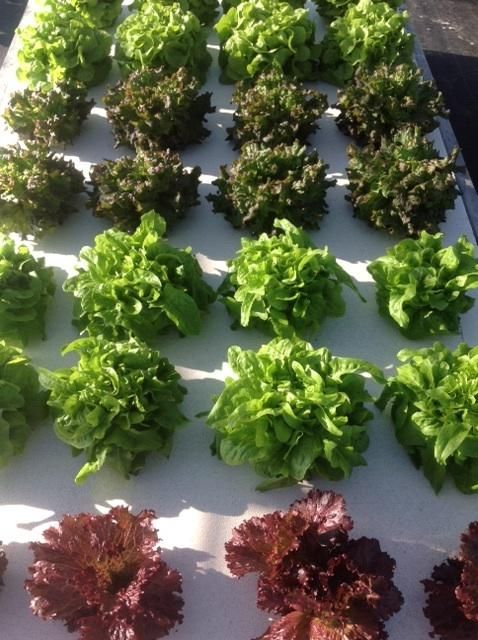
Credit: UF/IFAS

Credit: UF/IFAS
A third system gaining a great deal in popularity, especially in areas where land is at a premium, is the vertical tower method. Consisting of an upright pole with several polystyrene or plastic pots stacked one on top of another, these towers can be configured in many ways and suit many different types of crops. A second type of vertical system features an aeroponic tower (used without water culture or media), usually fabricated from plastic with various growing compartments. Whether placed outdoors or within greenhouses, these growing systems make use of vertical growing space, yielding efficient and dense plant capacity (Figures 4 and 5).
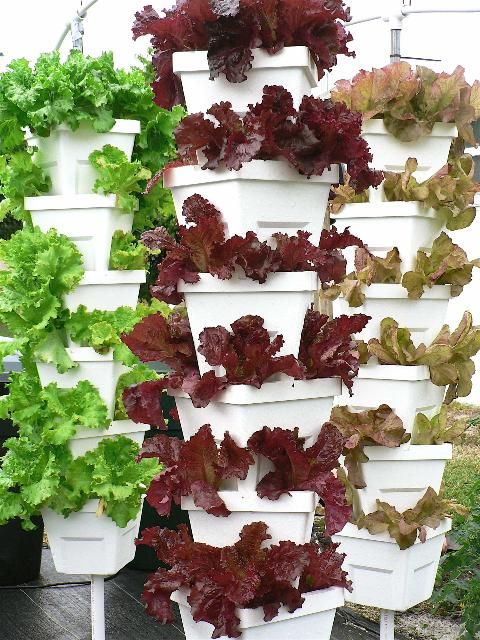
Credit: Natalie B. Parkell
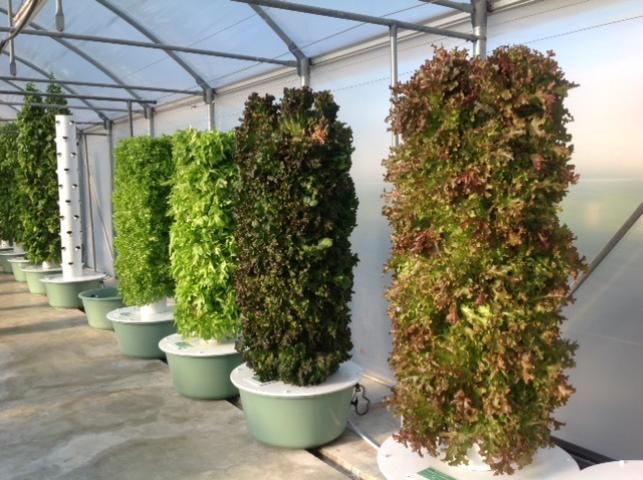
Credit: UF/IFAS
A final model for hydroponic lettuce production is the ground/landscape pot or upright plastic bag model. Usually filled with media such as coconut coir, perlite, or composted pine bark, these upright containers provide another cost-efficient way for farmers in Florida to efficiently produce lettuce for market (Tyson et al. 2013) (Figure 6).
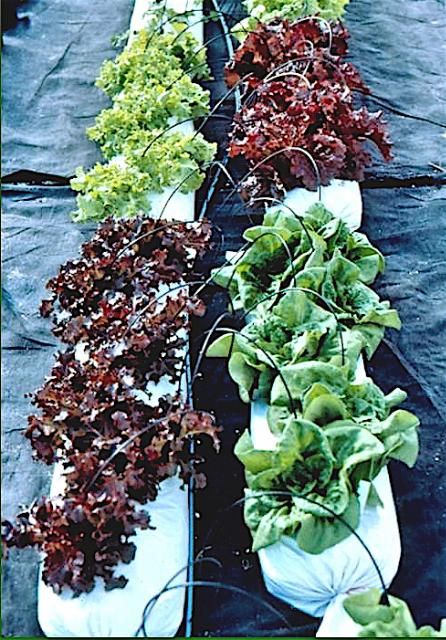
Credit: UF/IFAS
Regardless of the hydroponic production methods or systems used, there remain agronomic challenges for all farmers throughout the state. Any selection of protected agriculture will depend upon the predominant issues specific to the locale (e.g., protection from frost may be more of a consideration in Tallahassee than in Homestead), and wide variations will occur in the farm operations. In more northern Florida latitudes that bring sub-freezing temperatures on a regular basis, greenhouses are the industry standard for wintertime hydroponic lettuce production. Central and southern farmers often rely upon ventilated high tunnels during colder months and use shade structures to extend the season on either end when tropical temperatures and humidity are present. Depending widely upon the growing zone and what a farm operation is using to address adverse weather conditions, protective structures may allow for more versatility than traditional, field-crop models. Additionally, one must be careful to consider that the following specific lettuce cultivars are suggestions for farmers and do not actually guarantee successful cultivation techniques or profitable economic returns.
Lettuce Types
Lettuces generally are characterized by their head formation or leaf type. While crisphead or "iceberg" is by far the most common staple type grown in the United States, it is not yet considered appropriate or profitable for typical hydroponic production. The other main categories of lettuce types can be divided as follows:
Butterhead, Boston, or Bibb: This type is by far the primary greenhouse type overall. A delicate type, Butterhead is creamy-colored to light green on the inside and loose, soft, and ruffled green on the exterior. It is almost exclusively grown to full-head size for harvest (Figure 7).
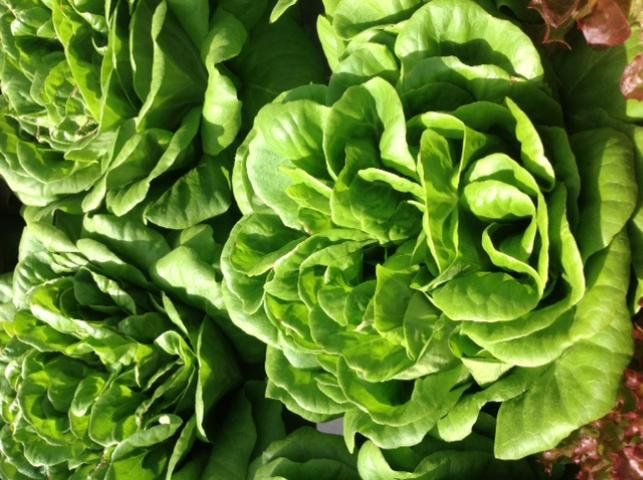
Credit: UF/IFAS
Looseleaf, Leaf, or Cutting: This is the second most commonly grown hydroponic lettuce type behind the Butterhead. The category of "leaf" lettuce includes many sub-categories, such as oakleaf, lollo, multileaf, summer crisp (somewhat of a cross between crisphead and true looseleaf, also referred to as French crisp/Batavia), and "Salanova." These types can be found in a wide variety of shapes, sizes, and colors, depending upon preference (Figure 8).
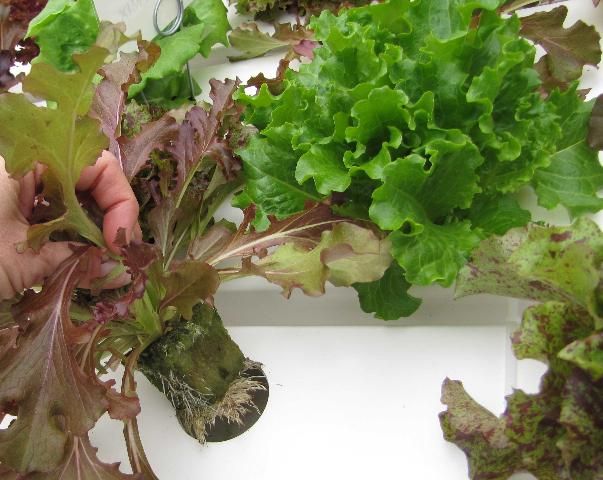
Credit: Natalie B. Parkell
Romaine or Cos: These lettuce types are typically a robust 8–12 inches tall and upright growing, with spoon-shaped, tightly folded leaves and thick ribs. Usually darker green on the exterior, they mellow to light green/white on the interior leaves. Romaine types of lettuce are grown equally for their full head as for their baby leaves for salad blends (Figure 9).
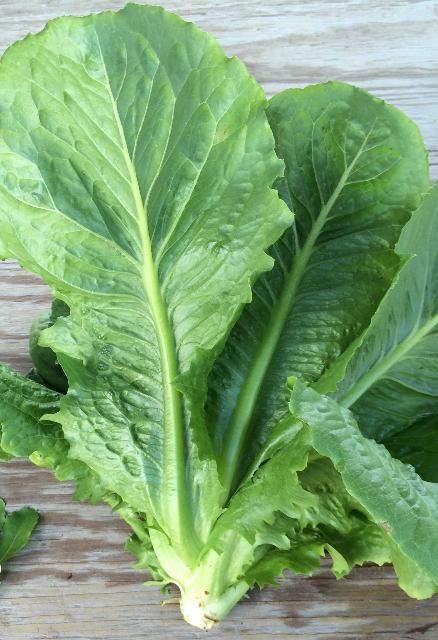
Credit: Kevin S. Osburn
Lettuce mixes/blends: A combination of several of the above types, these are often sold as pre-mixed seeds and are often grown in combination with other leafy greens for baby salad blends. This lettuce category is gaining in popularity as a marketing type for local farmers markets and restaurant sales (Figure 10).

Credit: Natalie B. Parkell
Literature Cited
Bunning, M. and P. Kendall. 2012. "Health Benefits and Safe Handling of Salad Greens." Colorado State University Extension Fact Sheet No. 9.373. https://extension.colostate.edu/topic-areas/nutrition-food-safety-health/health-benefits-and-safe-handling-of-salad-greens-9-373/.
Harlan, J. 1986. "Lettuce and the Sycomore: Sex and Romance in Ancient Egypt." Econ. Bot. 40:4–15.
Hochmuth, R. and D. Cantliffe. 2012. "Alternative Greenhouse Crops- Florida Greenhouse Production Handbook, Vol. 3." HS791. Gainesville, FL: University of Florida Institute of Food and Agricultural Sciences. https://edis.ifas.ufl.edu/cv272.
Hochmuth, R. and D. Toro. 2014. "Characterization of the Florida Fresh Fruit and Vegetable Industry Using Hydroponic Systems or Protected Agriculture Structures." HS1240. Gainesville, FL: University of Florida Institute of Food and Agricultural Sciences. https://edis.ifas.ufl.edu/hs1240.
McAvoy, E and M. Ozores-Hampton. 2014. "Cultivar Selection in Tomato and Pepper Production," IPM-202. Gainesville, FL: University of Florida Institute of Food and Agricultural Sciences. https://edis.ifas.ufl.edu/in755.
Tyson, R., R. Hochmuth, and D. J. Cantliffe. 2013. "Hydroponic Vegetable Production in Florida." HS405. Gainesville, FL: University of Florida Institute of Food and Agricultural Sciences. https://edis.ifas.ufl.edu/hs405.